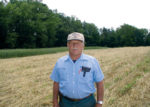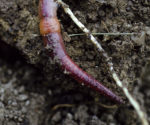Advertise Follow Us
Articles Tagged with ''soil''
Double-Cropping Veterans Share Expertise On Wheat, Soybeans
With attention to details, double-cropping systems cover the soil, improve soil health, ward off pests and diseases and protect profits, say veteran no-tillers John and Alexander Young.
Read More
What I've Learned from No-Tilling
Cover Crops Smother Weeds, Slash Input Costs, Bring Soils To Life
Manure, covers and more than 4 decades of no-till helped North Carolina farmer Ray Styer rejuvenate old tobacco acres and eliminate the need for commercial fertilizers on his small farm.
Read More
Rolling, Crimping Can Help No-Tillers Use Covers Better
Well-designed roller-crimpers, and a good management plan, can help no-tillers and strip-tillers smother weeds, improve soil protection and get the most from high-biomass cover crops.
Read More
How Earthworms Build Better No-Till Soils, Yields
Earth’s natural tillers do everything from supplying free “manure” to increasing nitrogen to spreading microorganisms and more.
Read More
Gypsum Balances Nutrients, Builds Up Soil Structure
Proper applications of gypsum, an efficient carrier of soluble calcium, can help no-tillers improve the soil environment for plants and reclaim problematic sodic soils.
Read More
No-Tillers Tame Heat And Tough Clay Soils
Relay soybeans, controlled traffic and cover crops play key roles in helping Randy and Nicole Small make no-till work in southeastern Kansas
Read More
Finding The Fertility ‘Gold Mine’ After A Dry Year
No-tillers could save inputs costs and raise yields by accessing residual nutrients in fields, but they need relevant data and must understand the factors that affect nutrient availability.
Read More
Switching Hybrids On The Fly Could Boost Corn Yields
Using equipment already available, Beck’s researchers are matching corn hybrids and populations to management zones, netting nearly 20 bushels an acre more in yields.
Read More












